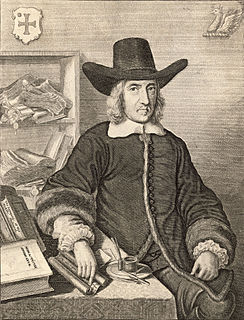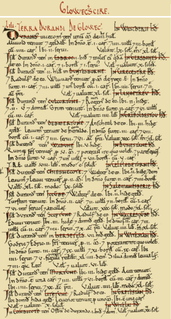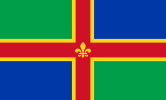
Sir William Dugdale was an English antiquary and herald. As a scholar he was influential in the development of medieval history as an academic subject.

Faversham Abbey was a Cluniac style monastery immediately to the north-east of the town of Faversham, in north Kent, England.
Simeon was a relative of King William I of England and the brother of Walkelin, Bishop of Winchester. It was through his brother's influence that Simeon was made prior of Winchester, then in 1082 Abbot of Ely, where he began work on the present Ely Cathedral. He recovered for the monastery of Ely the lands which had been allotted to the Normans during their siege of the island of Ely when it was held by Hereward the Wake.
Pontefract Priory was a Cluniac monastery dedicated to St. John the Evangelist, founded about 1090 by Robert de Lacy, 2nd Baron of Pontefract, and located in Yorkshire, England. It existed until the dissolution of the monasteries. The Church and buildings have been completely destroyed, but the site is still indicated by the name of Monk-hill.

The Cluniac Priory of Wangford was a small religious house in Wangford in the English county of Suffolk. It was founded before 1159 as a dependency of Thetford Priory. In 1376, it was naturalised before being dissolved in 1540.
Isabella de Say (c.1132-1199) was an Anglo-Norman heiress. Isabella was the only surviving child of Helias de Say upon his death in 1165; Helias was the third lord of Clun, a powerful Norman stronghold in Shropshire, England, along the Welsh border. She is notable for helping to create the powerful medieval house of the Fitz Allans. Isabella married William Fitz Alan, the lord of nearby Oswestry, as his second wife in 1156. William died in 1160, leaving a son by his first wife, Christiana, William Fitz Alan II. Isabella passed Clun Castle to him. The combined lordship of Oswestry and Clun was a significant power in the borderlands with Wales.
The Priory of St Mary, Huntingdon was an Augustinian Priory in Huntingdonshire, England.
Horton Priory was a priory at Horton in Dorset, England.

Little Dunmow Priory in Little Dunmow was an Augustinian priory in Essex, England. The priory was founded as a church by Juga de Baynard in 1104, dedicated to the Blessed Virgin Mary and consecrated by Maurice, bishop of London. Juga was the widow of Ralph Baynard, baron of Little Dunmow, sheriff of Essex and builder of Baynard's Castle. Her son Geoffrey was sheriff of Yorkshire who, in 1097, beat William II, Count of Eu in a trial by battle. After her death (c.1106), and following her wishes and the advice of Anselm, bishop of Canterbury, Geoffrey populated Juga’s church with Augustinian canons. In 1110, Lady Juga’s grandson, and Geoffrey’s son, William de Baynard, fell from grace and lost his lands. Henry I gave those lands to Robert Fitz Richard, but Henry and his wife Matilda of Scotland confirmed the canons’ possessions in Little Dunmow. Robert’s wife Maud, the step-daughter of Matilda’s brother David I, gave more lands to the canons, establishing the priory in perpetuity.

Kirby Bellars Priory was a small priory of Canons Regular of Saint Augustine in Leicestershire, England. It is now the Church of England Parish Church of Saint Peter's serving the village of Kirby Bellars.

Newsham Abbey was an abbey in Newsham, a small hamlet north of Brocklesby village in Lincolnshire, England. Founded by Peter of Gousla in 1143, Newsham was a daughter house of the Abbey of Licques, near Calais, and the first Premonstratensian house established in England.
Letheringham Priory was a priory in Suffolk, England.
William d'Aubigny, sometimes William de Albini, was an Anglo-French baron and administrator who served successive kings of England and acquired large estates in Norfolk. From his title of Butler to King Henry I of England, he was called William d'Aubigny Pincerna to distinguish him from other men of the same name.
William de Kirkeby was prior at Wallingford Priory in the late 13th century.

St Peter's Church is the parish church of the town of Barnstaple in North Devon, England. Parts of the church date to the 13th-century with much restoration during the Victorian era by George Gilbert Scott and later by his son John Oldrid Scott which changed the atmosphere of the building, although many fine wall monuments and tablets remain. The church comes under the Diocese of Exeter.
Robert II de Vaux of Pentney also known as Robert de Vallibus, Lord of Pentney, was a prominent 12th-century noble. He succeeded to the lands in Norfolk, Suffolk and Essex in England, held by his father Robert which had been received from Roger Bigod after the Norman conquest of England. Robert was the founder of the Augustinian Pentney Priory, dedicated to the Holy Trinity, St Mary and St Magdalene, which he established c.1130, for the souls of Agnes his wife and their children. He was succeeded by his eldest son William.
Roesia de Verdun, also spelled Rohese and Rose, was a Norman femme sole and one of the most powerful women of Ireland in the 13th century.

Durand of Gloucester was Sheriff of Gloucestershire in 1086 and was one of the tenants-in-chief of King William the Conqueror in Gloucestershire and elsewhere, with a total of 63 holding listed in the Domesday Book of 1086.










